Thin Films Prepared from Nanometer Size TiO2 Absorbs Millimeter Waves
Abstract
Absorption of average 10 nm size TiO2 nanoparticles deposited on glass surfaces as a thin film using convective assembly technique and drop-casting is studied in the millimeter wave range from 26 GHz to 40 GHz. The millimeter wave responses of the fabricated samples were obtained using a vector network analyzer. Reflection properties of the prepared samples were also measured. Absorption and reflection of TiO2 nanoparticles were more pronounced between 35 GHz and 40 GHz compared to glass-only sample.
1. Introduction
Titanium dioxides find broad range of applications from pigment to cosmetic industry, electronic to pharmaceutical industry [1–10]. The reason behind their wide applicability is their unique properties such as blocking UV light and photocatalytic activity [11]. Additional exceptional properties such as cleaving proteins at amino acid proline site and behaving as a semiconductor of nanosized TiO2 were also reported [12, 13].
As the nanotechnology progresses, new properties of TiO2, especially in their nanoscale form, are explored. For example, the millimeter wave rotational spectrum of TiO2 at ground state was obtained in [14] for astronomical searches. Microwave absorbing effects and characterization of TiO2 were also studied in [15, 16]. The absorption characteristics of TiO2 nanoparticles have been mostly overlooked and this study aims to fill this gap for numerous engineering applications.
There are a number of methods such as spin coating, dip coating, and drop-casting to prepare relatively uniform thin films from nanomaterials. In this study, we used two different approaches to prepare TiO2 thin films, drop-casting and “convective assembly”. While former approach generates thin film thickness in millimeter range, the latter generates in the micrometer range. The “convective assembly” is an approach to assemble 2D and 3D nano- and micrometer size structures using nano- and micrometer size particles on surfaces in a more controlled manner. The assembly of a number of particles on surfaces was achieved using the approach [17, 18]. The self-assembly of colloidal particles in thin evaporating films is the basis of the technique [19, 20]. It was also used to assemble bacteria-silver nanoparticle and protein-silver nanoparticle structures on glass surfaces [21, 22].
2. Material and Methods
10 nm TiO2 nanoparticles were used to prepare thier thin films on glass surfaces. Figure 1(a) shows the TEM images of TiO2. As seen on the image, the average size of TiO2 nanoparticles is 10 nm. An 8.6 mg of TiO2 was suspended in distilled water. A “convective assembly” was used to deposit TiO2 as a thin film on a glass surface. The details of the experimental setup could be found elsewhere [17]. Briefly, an 80 μL of TiO2 suspension was placed at the cross section of two glass slides, which are soaked in Piranha solution for at least 3 hours to clean the glass surface, one is placed on a moving stage and the other is placed on top of the one placed on the moving stage with an angle of 23°. In order to generate thicker films on the glass surface, 4–6 mL of suspension of TiO2 was placed on the glass cleaned glass slide and the suspension was distributed on the glass surface with the help of another slide. Figure 1(b) shows the images of thin films prepared with two different approaches on the glass surface. The thickness of thin film prepared with convective assembly estimated as 10 μm and the film prepared with drop-casting was estimated as 1 mm.
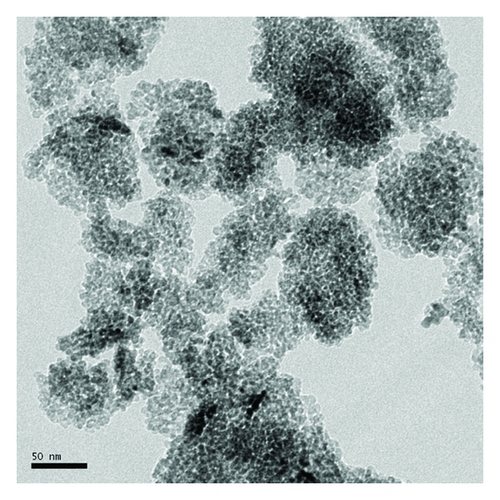

Figure 2 shows the UV/Vis spectrum of the suspension of TiO2 nanoparticles in water.
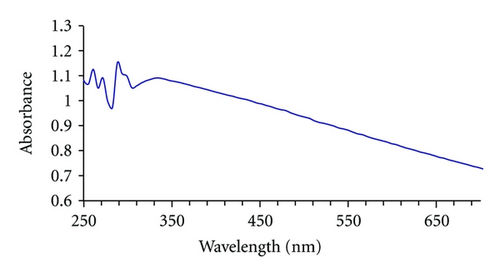
Millimeter wave measurement setup is shown in Figure 3. Rohde and Schwarz ZVA40 Network Analyzer was calibrated from 20 to 40 GHz with intermediate frequency at 1 kHz, and the number of calibration points was set to10,000 with source power level at +5 dBm. Network Analyzer as a two-port device can simultaneously measure input reflection and transmission to the other port in terms of Scattering (S) parameters. In this configuration S21 represents signal received at port 2 when input signal is applied to port 1, with 50 Ohm port impedances. S21 is used as the main data for comparison of detection. Wideband conical antennas made by Elmika were used for transmission and reception. Although the antennas were rated from 26.5 to 40 GHz, their port match and gain were found satisfactory starting from 23 GHz. Nevertheless, measurements were carried out relative to glass-only sample, and basis of comparison was made with reference to that sample. Samples were held using Rohacell air-dielectric foams.
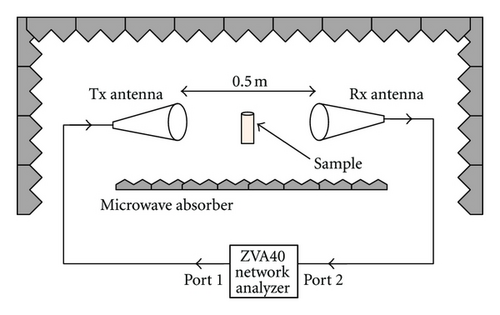
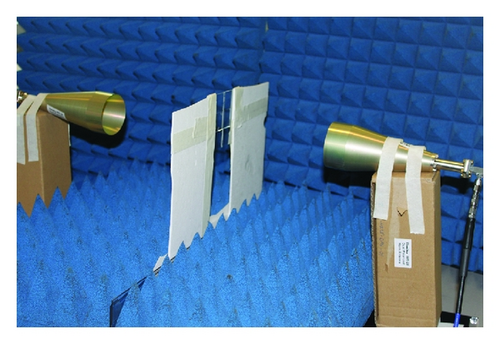
3. Results and Discussion
Measurement setup was first used for free space and thin-glass samples to create a reference. Transmission measurement of S21 is recorded for both configurations. Since the samples are in the far field of the receiving and transmitting antennas and reflection from the samples is quite close to each other, one can infer absorption of samples directly from transmission measurements. Comparisons of transmission measurements for free space and glass-only sample are shown in Figure 4. The measurement result is also expressed in dB scale with 20log(S21) conversion.

Next, same measurement setup was used to measure absorption characteristics on TiO2 thin films deposited on glass surface using drop-casting technique. The samples prepared using convective assembly were very thin to produce strong absorption. Therefore, samples prepared through drop-casting were used in the measurements. Results are shown in Figure 5. It is observed that there is a degradation TiO2 deposited glass sample compared to glass-only sample. Especially between 35 GHz to 40 GHz, absorption of TiO2 sample is at least 2.5 to 3 dB higher than that of glass-only sample. The reflection measurements of both samples are also shown in Figure 6. The reflection measurements also show a clear departure from glass-only sample from 35 GHz to 40 GHz.
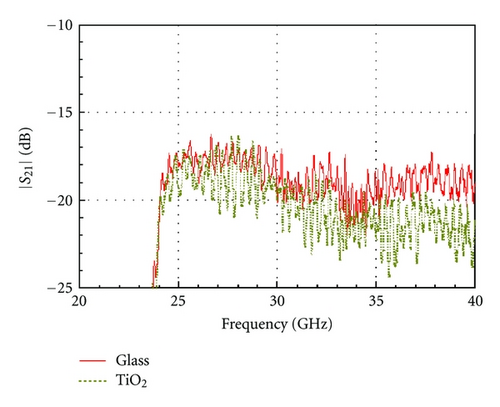
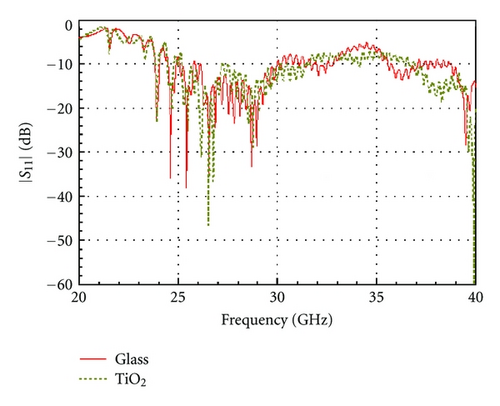
The relative percent change in received signal with respect to glass-only sample is shown in Figure 7. TiO2 sample has in excess of 15% relative percent change from 35 to 40 GHz.
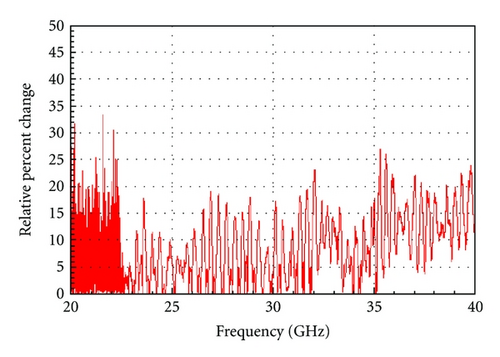
Even though the measurements were carried out at atmospheric pressures and at room temperature, there is a clear difference between glass-only and TiO2 thin film deposited glass samples. The attenuation of TiO2 sample is consistently higher than that of glass-only sample.




